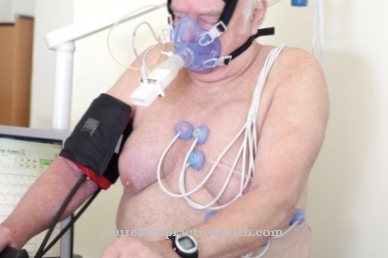In the Noise audiometry according to Langenbeck the hearing threshold is determined for different pitches with simultaneous superimposition of the pure tone with background noise.
The audiometric test allows conclusions to be drawn as to whether there is a sensorineural damage, i.e. damage to the sensor system (sensors in the cochlea) and / or in the downstream neural area. The method was developed and presented by Bernhard Langenbeck in 1949 and 1950.
What is noise audiometry?

The noise audiometry according to Langenbeck differs from the "normal" tone audiometry in that, in addition to determining the hearing threshold for frequency-dependent tones in the form of absolute or relative sound pressure levels, the individual tones are underlaid with noise of constant intensity.
The sound pressure level of the noise is selected in such a way that it conceals the individual quiet threshold in the middle frequency range, but lies below the threshold for pure tones for high and low tones. Above all, the method allows conclusions to be drawn as to whether, in the case of reduced hearing, the cause is damage to the sensory cells in the cochlea or damage to the downstream transmission path (auditory nerve) or the neuronal processing centers.
In the case of an impaired function of the receptors in the cochlea, the test persons perceive a less strong overlap of the pure tones to be heard than in the case of a subsequent nervous hearing loss. A possible sound conduction or sound sensation disorder can be clarified in advance by comparing the hearing thresholds between structure-borne sound and air-conduction sound.
Function, effect & goals
If there is a suspicion of impaired hearing, it is initially of interest to confirm or dispel the suspicion by means of subjective and objective tests. If a hearing impairment is confirmed, it must be found out in the sense of a successful therapy what the causes of the impaired hearing ability lie.
In principle, there may be mechanical-physical impairments such as an external auditory canal clogged with ear wax or the eardrum can be damaged and temporarily or permanently impaired in its function. In some cases, the ossicles that mechanically transmit sound are also diseased or calcified (otosclerosis) and lead to problems with sound conduction. Other causes can be a functional restriction of the sensory hairs in the cochlea, which convert the "heard" tones into electrical impulses, or there are problems with the downstream neural processing of the hearing signals.
If a sound conduction disorder can be ruled out, so that a sound sensation disorder can be assumed to be the cause of a diagnosed hearing impairment, Langenbeck's noise audiometry is an extended diagnostic method played the left or right ear and at the same time superimposed with a permanent noise. This is what is known as “white noise”, which has a constant power density in a limited frequency spectrum.
The sound pressure of the noise is chosen so that it is above the perception threshold for tones of medium frequency (1 to 4 kHz), but below the perception threshold for low and high tones. In contrast to audiograms without background noise, for which the individual hearing thresholds are usually entered as a deviation relative to the normal values, it is common in noise audiometry to enter the hearing thresholds as absolute sound pressure levels on a corresponding form. This makes the influence of the background noise on the hearing threshold of the pure tones clearly visible. The results of the Langenbeck test procedure show whether there is a neuronal or a sensory problem.
In the case of sensory (cochlear) hearing impairment, pure tones are less obscured by the background noise than in the case of neuronal weakness of sound perception. In the case of cochlear hearing loss, the pure tone points - similar to people without hearing problems - are at the level of the noise and, in the case of the low and high tones, lead to the resting hearing thresholds that are not accompanied by noise.
In the case of neuronal hearing impairment, the patient only perceives the pure tones at a higher sound pressure than the noise. In the recording diagram, the thresholds of hearing of the pure tones are therefore always below the "noise level". So to speak, they evade the non-hidden hearing threshold. The recorded auditory threshold points in the diagram for noise audiometry according to Langenbeck already give a clear visual indication of whether there is a cochlear or a retro-cochlear, i.e. a downstream neuronal, problem.
You can find your medication here
➔ Medicines for ear complaints and hearing problemsRisks, side effects & dangers
Audiograms are not only used to determine and localize conductive or sensorineural hearing loss, but can also be used to prove that the subject's hearing ability corresponds to normal hearing within a predetermined range.
This is e.g. B. a common practice for determining the fitness of professional and airline pilots. In cases in which one of the two ears has a significantly poorer hearing, the problem of "overhearing" arises. The ear with the better hearing ability can perceive the sound played through headphones more easily than the "poorer" ear, which can falsify the result of the audiogram because the patient does not notice that he is hearing the sound to be recognized with the "wrong" ear.
Overhearing usually happens when the hearing threshold of the poorer ear is more than 40 dB above that of the better hearing ear. In order to still achieve an unadulterated result, the better ear is "deadened". A loud noise is made to temporarily desensitize it to the test tone. When setting the sound pressure level for the masking noise, the discomfort threshold above which the noise is perceived as unpleasant or even painful must be taken into account. No other dangers or side effects of a Langenbeck noise audiogram are known.
















.jpg)
.jpg)



.jpg)






